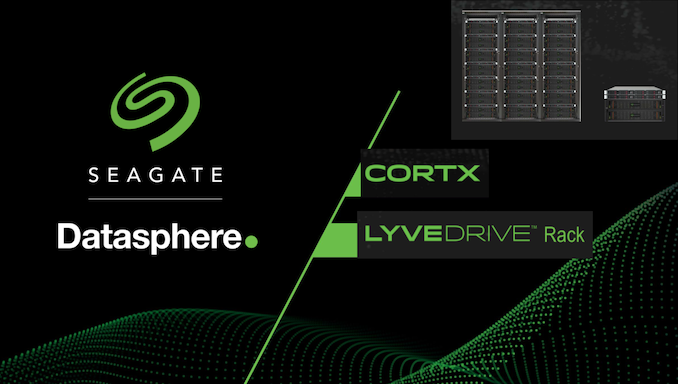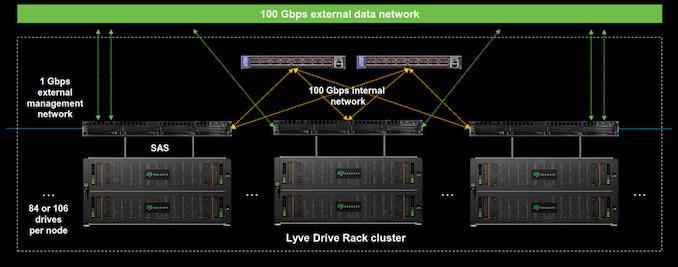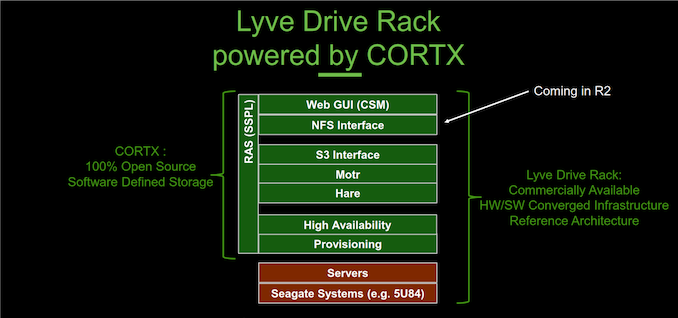Seagate Unveils CORTX Object Storage Software with Lyve Drive Rack Hardware Reference Design
by Ganesh T S on September 24, 2020 1:05 PM EST- Posted in
- Storage
- Seagate
- HAMR
- HDD
- Software-Defined Storage

Seagate has unveiled CORTX, an open-source S3-compatible object storage software, today at their Datasphere virtual event. The source for this software-defined-storage (SDS) platform is hosted on Github. Seagate has also organized a group of open source researchers and developers in this space under the 'CORTX Community' moniker. As part of the Github repository, Seagate is providing a pre-built virtual machine image that enables users to get a quick start with testing.
Seagate is a hardware vendor at its core, and as part of the CORTX initiative, it is also introducing the Lyve Drive Rack - a reference architecture supported by Seagate and available later this year with 20TB HAMR drives.
The Lyve Drive Rack is expected to serve a variety of use-cases including backup/restore, big data and analytics, AI & ML, file sharing and synchronization, as well as video surveillance. Each rack node can support up to 106 drives, and a cluster can scale up as necessary.
It makes sense for Seagate to open source CORTX, as it helps them push support for emerging hardware upstream to drive up adoption rates. It is better for the community as a whole, as there is no vendor lock-in with proprietary architectures. It essentially eliminates object softwre licensing costs from the datacenter stack. Private cloud infrastructure also receives a fillip, with the capabilities and capacities available with the hyperscalers becoming more accessible.















5 Comments
View All Comments
zachj - Thursday, September 24, 2020 - link
Wtf would they invest money into authoring yet another open source s3 implementation? What's wrong with all the other implementations that was better fixed by building another than by contributing to the existing projects?s3adam - Thursday, September 24, 2020 - link
In their event they said they do it because their largest drives are immediately adopted by cloud but not by enterprise. Their github has a FAQ that discusses this too.alyarb - Thursday, September 24, 2020 - link
They need to offer block and file services if they want attention from enterprise and the rest of the world. With few exceptions object-only ultimately means cloud-only.At any rate it would be pretty difficult to unseat Ceph at this point.
Kyubre - Thursday, September 24, 2020 - link
A bit of a caveat/confession up-front. I am not unbiased. I wrote an HSM connector for a luster about two years ago and have been very involved with pushing CEPH to its peak performance since then.I know a few of the folks that took both Luster and Ceph as their reference point and who asked themselves if they could do it better with 15 years of hindsight. As JBODS yield to RBODS and geographic replication learns erasure coding, I think they found a way to do better.
Before sloughing off the struggle of old dogs having to learn new tricks we should consider not one open-source object store on the planet was invented before storage drives reached their CHS limits. Things have changed.
It's not perfect, but the storage subsystem of CortX is worth taking a look at. Even if you have to learn some new tricks...
Altuzza - Tuesday, May 4, 2021 - link
Although it can take extra resources, time and money, good customer service leads to customer satisfaction which can generate positive word-of-mouth for your business, keep your customers happy and encourage them to purchase from your business again. Good customer service like this one https://wow24-7.io/ can help your business grow and prosper.